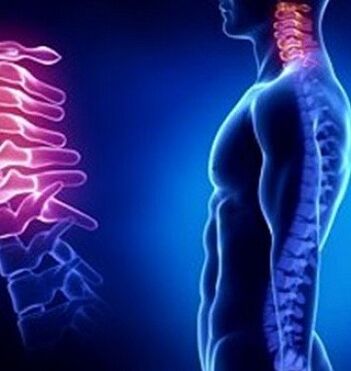
With osteochondrosis, there is a gradual destruction of spinal tissue, which leads to its dysfunction. Usually such degenerative processes develop in its most mobile departments. Cervical osteochondrosis is most common in young people. The instability of this department, combined with increased physical activity, explains its sensitivity to injuries and various dystrophic processes. It causes sudden headaches in 3 out of 10 cases. Osteochondrosis causes metabolic disorders in the spine. Therefore, the discs inside come out, and then crack.
Symptoms
Several symptoms may indicate dystrophic changes in the spine. Depending on the stage of the disease, they are more pronounced or weaker. Cervical osteochondrosis has the following symptoms:
- Pain in the neck, neck, shoulders. Strengthens even with a light load
- Dislocation in the limbs.
- Cracking when turning the neck.
- The headache is mainly localized in the occiput and temples.
- Fainting, chronic fatigue.
- Noise in the ears, hearing loss.
- Loss of visual acuity.
Cervical osteochondrosis can also be manifested by pain in the heart area. The patient often has feelings similar to angina pectoris. When the spinal cord is compressed, other disorders also occur. For example, loss of sensitivity of the tongue or decreased tone of the neck muscles, respiratory problems. If treatment is not prescribed in time, the patient may develop a bulge or hernia.
There are four stages of osteochondrosis. The first is characterized by instability in the intervertebral discs. Second, protrusions are the main sign. In this case, the gaps between the vertebrae are reduced. There is a pain syndrome that can be associated with compression of the nerve roots.
In the third stage, the destruction of the fibrous ring, which is part of the intervertebral disc, occurs. Therefore, it is subsequently deformed. A patient with the fourth stage of cervical osteochondrosis feels severe pain with any movement. It should be noted that the decrease in its intensity does not indicate recovery. On the contrary, it marks the beginning of the formation of osteophytes that connect the vertebrae. As a rule, it leads to disability. Treatment is prescribed based on clinical signs and stage of pathology.
Causes of the disease

Sedentary work is most often accompanied by cervical osteochondrosis. This section of the spine is quite compact, so a small amount of muscle tension inside causes the nerve endings and blood vessels to constrict. Against this background, osteophytes often appear, which worsens the situation. In addition to a sedentary lifestyle, it can cause illness:
- metabolic disorders;
- nutrition;
- salt deposition in the cervical spine;
- hypothermia;
- hereditary predisposition;
- injuries of the cervical spine;
- rheumatism.
The cause of the disease may be curvature of the spine or overweight. The risk group includes people with poor physical fitness or athletes who make mistakes in the training process.
Which doctor treats cervical osteochondrosis?
At the first signs of compression of the nerve roots of the spine, you should seek the help of a medical professional to prevent the development of complications. Cervical osteochondrosis and its symptoms are treated by neurologists, chiropractors, osteopaths.
In addition, you may need to consult a neurosurgeon, traumatologist, therapist, cardiologist. To differentiate the diagnosis, the doctor analyzes the patient's complaints. At this stage, the patient asks the following questions:

- When did neck pain first appear?
- Are other symptoms accompanied by cervical osteochondrosis?
- Is the patient's professional activity related to lifting weights or keeping the neck motionless for a long time?
- What is the patient's fitness level?
- Does the patient have symptoms of neurological disorders?
Your doctor will order an x-ray, CT or MRI to assess the condition of your spine. Depending on the symptoms and stage of the disease, treatment may include massage, swimming and exercise therapy. Local destruction processes are affected by acupuncture. With severe pain syndrome, the doctor prescribes anesthetics. Muscle tension is relieved with muscle relaxants. In advanced cases, surgery is required if the patient has a hernia that compresses the roots of the spinal cord.
What to do if the disease is not treated?
In the absence of specialized medical care, the patient eventually develops chronic pain in the cervical spine. It radiates to the upper and lower extremities, which is full of paralysis. As osteophytes grow, they constrict nerve channels, blood vessels, and arteries. This can disrupt the cerebral circulation. This often leads to ischemia and stroke. The patient also appears vision, hearing, migraine and vegetovascular dystonia.
Doctors who study cervical osteochondrosis and its clinical symptoms often diagnose radiculopathy. Leads to partial or complete loss of vertebral mobility. Exacerbations are one of the reasons for hospitalization. The most serious consequence of cervical osteochondrosis is compression of the spinal cord. In this case, the risk of death is very high. It is necessary to consult a doctor as soon as possible to prevent the development of complications. The operating mode should be gentle. You should do special gymnastics every day, if possible in the morning.


























